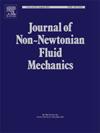On the use of sinusoidal vibrations for disaggregating clusters of non-settling inertial particles immersed in yield-stress fluids
Abstract
The effect of sinusoidal vibration is numerically investigated on the dynamical behavior of a cluster of 50 identical non-Brownian circular solid particles randomly distributed in a circular envelope. The cluster is immersed in a finite vessel filled with an inelastic viscoplastic fluid obeying the Casson model. The solid particles are modeled using the improved smoothed-profile method (iSPM) whereas the flow of the continuous phase is modeled using the lattice Boltzmann method (LBM). An in-house LBM-iSPM code, modified for Casson fluid, is used to study the effect of sinusoidal vibration on disaggregating the cluster. We have deliberately ignored the gravitational term in the equations of motion so that the sole effect of vibration on the cluster response can better be investigated. Numerical results suggest that vibration can disaggregate the cluster with its efficiency depending on the fluid's yield stress. For any given yield stress, vibration can disperse the cluster provided the frequency and/or amplitude of the forced oscillation are larger than a threshold. The secondary flow formed in the channel during the transient phase is shown to be the main cause of the cluster's fluid-mediated dispersion. It is shown that the system reaches equilibrium when the secondary flow is vanished through dissipation. Vibration is predicted to become more effective in disaggregating clusters the larger the size of the particles or the smaller their number density.

 求助内容:
求助内容: 应助结果提醒方式:
应助结果提醒方式:


